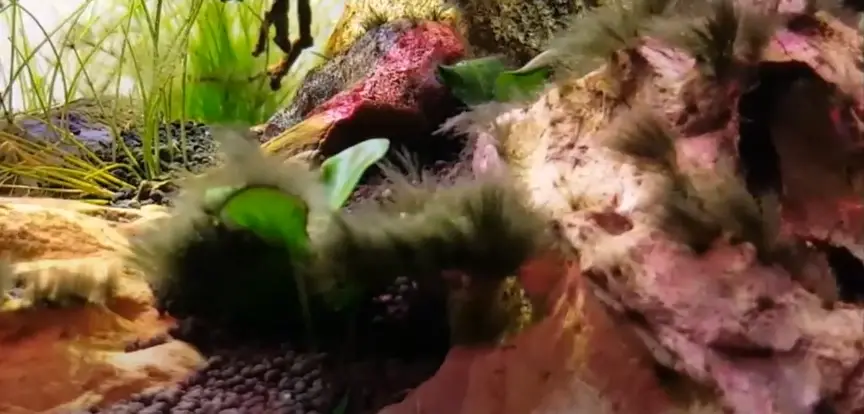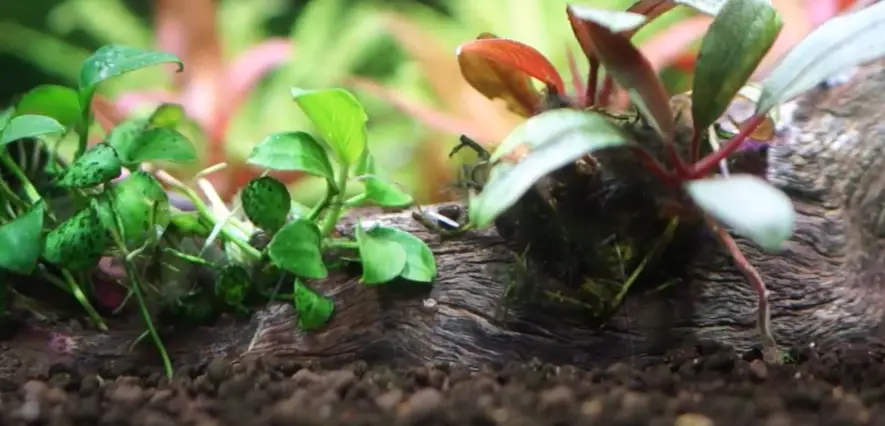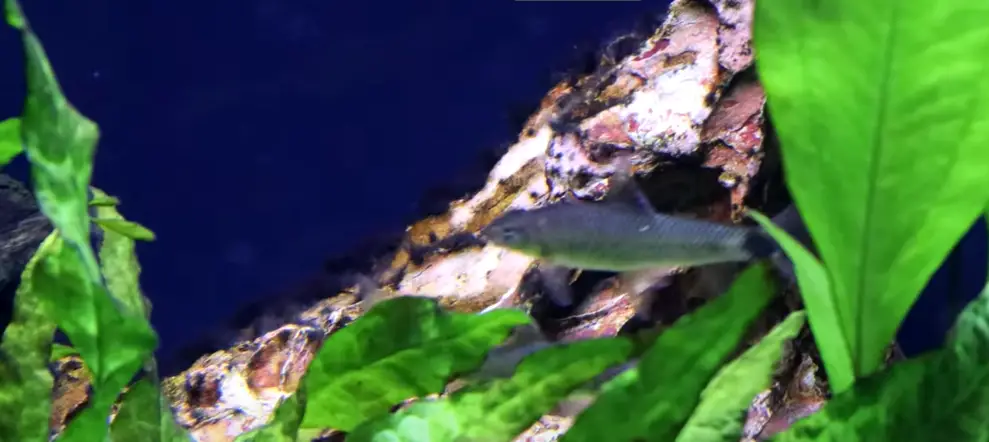As an avid aquarium enthusiast, I’ve often noticed black spots on aquatic plants and wondered what could be causing them. I’ve learned that the culprit is usually a type of algae known as black beard algae or black brush algae. This algae can be quite unsightly and may impact the overall health of the plants and the fish in the tank.
This article will delve into the causes of black algae, how it enters our tanks, and its possible effects on fish health and plant growth. We will also discuss the best ways to eliminate black spots and prevent future algae outbreaks.
Causes of Black Algae
Understanding the root causes of black algae is essential to effectively tackle the issue and maintain a healthy aquatic environment for your underwater flora. Black spots on aquarium plants may indicate the presence of black algae, also known as black beard or black brush algae.
This type of algae typically appears when there is an imbalance in your aquarium’s ecosystem, often due to excess nutrients, poor water quality, or insufficient lighting. As a diligent and observant aquarist, it’s crucial to recognize the signs of black algae on aquarium plants and take steps to address the causes before it becomes a more significant issue.
One of the primary causes of black spots on aquarium plants is excess nutrients in the aquarium water. Overfeeding your fish or using too much fertilizer for your plants can lead to a buildup of nutrients, such as phosphates and nitrates, which can fuel the growth of black algae. To prevent this, feeding your fish the appropriate amount of food and using the recommended dosage of plant fertilizers is essential.
Additionally, regular water changes and a good quality aquarium filter can help maintain a stable nutrient balance in your tank, keeping black algae at bay.
Insufficient lighting is another factor that may contribute to the growth of black bead algae. Aquarium plants require adequate light to photosynthesize and outcompete algae for nutrients. However, if your aquarium lighting is too weak or not on for sufficient time each day, your plants may struggle to grow, and algae may take over.
To combat this issue, ensure that your aquarium has the appropriate amount of light for the types of plants you are growing, and consider using a timer to ensure consistent lighting each day.
Addressing these underlying causes can help create a healthier and more balanced environment for your aquarium plants, ultimately keeping black algae under control and allowing your underwater garden to thrive.

Getting Rid of Black Spots
So, you’ve noticed some unsightly blemishes on your underwater greenery, and you’re itching to get rid of them, right? Those black spots on aquarium plants can take away from the beauty of your aquatic environment, but fear not! You can effectively remove those pesky marks and prevent future outbreaks with diligence and knowledge.
In this article, I’ll share some methods for removing black spots on aquarium plants and tips for preventing black algae outbreaks in your fish tank.
To start, let’s tackle the removal process. There are a few ways you can go about this, but I’ve found the following methods to be particularly effective:
- Manual removal: Carefully remove the affected leaves or scrub the spots off with a soft brush. Be gentle to avoid harming your plants.
- Hydrogen peroxide: You can use hydrogen peroxide for black algae removal. Simply dilute it with water (3% hydrogen peroxide solution) and apply it to the black spots using a cotton swab.
- Biological control: Introduce black algae-eating fish to your aquarium, such as Siamese algae eaters or mollies. These fish will naturally control the black algae growth and help maintain a clean environment.
- Preventing black algae outbreaks: Regular maintenance and water changes are crucial to preventing black algae outbreaks in your fish tank. Keep a close eye on your water parameters and ensure you provide adequate lighting and nutrients for your plants.
As you can see, it’s not too difficult to address the issue of black spots on aquarium plants once you know what to do. By removing the spots and taking steps to prevent future outbreaks, you’ll be doing your part to create a healthy and beautiful underwater environment for your fish and plants. And as you serve your aquatic friends in this way, you’ll also be serving yourself by fulfilling that subconscious desire to care for others. So dive in, and enjoy the satisfaction of a spotless, thriving aquarium.

How Black Algae Enters Tank
You might be wondering how those pesky black algae find their way into your tank in the first place, right? Well, let me tell you, black algae spores in fish tanks can enter through various sources, and it’s essential to understand these sources to prevent those black spots on aquarium plants.
One common way black algae enters your tank is by hitching a ride on new plants, decorations, or even fish. That’s why it’s crucial always to purchase tank items from reputable stores and quarantine new fish before adding them to your main tank.
Another way black algae can sneak into your tank is through contaminated water. When you top off your tank or change water, ensure you’re using treated and clean water, as untreated tap water can contain spores that lead to black bread algae growth. Additionally, even though black algae might not be visible initially, it can still be present in a microscopic form in your tank, just waiting for the right conditions to thrive.
This is why keeping a close eye on your tank’s water parameters is essential, as imbalances can create an environment where black algae flourish. So, what can you do to prevent black algae from entering your tank? First, thoroughly inspect and clean any new plants, decorations, or equipment before placing them in your tank.
Next, quarantine new fish and perform regular water changes using treated water to maintain your tank’s health. Lastly, keep a watchful eye on your water parameters and address any imbalances promptly. By taking these steps, you’ll be doing your part to create a healthy, algae-free environment for your fish and plants, and ultimately, serving the greater good of your underwater community.
Impact on Fish Health
Undoubtedly, witnessing those unsightly dark patches invading your tank can be disheartening, but have you considered the potential harm they can cause to your beloved fish? Black spots on aquarium plants, commonly known as black beard algae, can indicate an imbalance in your tank’s environment.
Apart from being an eyesore, these algae can negatively impact the health of your fish and the overall well-being of your aquarium’s ecosystem. Here are five ways that black beard algae can harm your fish and aquarium plants:
- Competition for nutrients: Black beard algae can outcompete your plants for essential nutrients, making it harder for them to grow and thrive.
- Oxygen depletion: As algae grow, they consume oxygen, lowering oxygen levels in the tank and stressing your fish.
- Stress to fish: A tank infested with black beard algae can create an uncomfortable environment for fish, leading to stress and potential illness.
- Hindered plant growth: The physical presence of algae on plants can block light and impede photosynthesis, which can stunt the growth of your plants and affect the overall balance of the tank.
- Tank maintenance challenges: Black beard algae often signals a larger issue with water quality and tank maintenance, leading to further complications if not addressed.
So, how can you protect your fish and plants from the harm of black beard algae? Proper maintenance of your fish tank is crucial in preventing and controlling the growth of these algae. Regular water changes, monitoring water parameters, and ensuring your plants receive adequate light can help maintain a healthy tank environment.
Additionally, removing any visible algae from plants and tank surfaces can prevent them from spreading and causing further harm. By being observant, diligent, and knowledgeable about the impact of black spots on aquarium plants, you can keep your fish happy and healthy.
Remember, taking proactive steps towards proper maintenance of your fish tank can prevent the growth of black beard algae, ensuring a balanced and thriving ecosystem for both your fish and plants.

Effects on Plant Growth
It’s not just your fish that suffer; these pesky algae can wreak havoc on your plants’ growth and overall health. Aquarium plants with black spots are often a sign of a larger issue within the tank, and if left untreated, the consequences can be dire for both the plants and the fish.
One major factor that can lead to these unsightly black spots is an imbalance in the light levels in the aquarium. Too much light can encourage algae growth, while insufficient light can hinder your plants’ ability to photosynthesize and grow.
| Effects on Plant Growth | Prevention of Black Spots |
|---|---|
| Stunted growth | Maintain proper light levels in the aquarium |
| Reduced photosynthesis | Limit excess nutrients in the water |
| Weakened plants | Use proper filtration systems |
| Increased algae growth | Introduce algae-eating organisms |
| Unhealthy environment | Regularly clean and maintain the aquarium |
The consequences of black spots on aquarium plants go beyond aesthetics. Stunted growth and reduced photosynthesis can make weakened plants more susceptible to diseases and pests. This, in turn, can create an unhealthy environment for both the plants and the fish in the tank. To prevent these issues, it’s crucial to maintain proper light levels in the aquarium, limit excess nutrients in the water, use adequate filtration systems, introduce algae-eating organisms, and regularly clean and maintain the tank.
Taking the time to address and prevent the development of black spots on your aquarium plants will improve their growth and health and create a more harmonious environment for the fish that call your tank home. By being observant, diligent, and knowledgeable about the factors contributing to these issues, you can ensure that your plants and fish thrive in a clean, healthy, and visually appealing aquarium. So take action today and make a positive difference in the lives of your aquatic friends.
Preventing Algae Outbreaks
Preventing algae outbreaks is essential for maintaining a vibrant and healthy underwater environment that both your fish and plants will surely appreciate. Algae can quickly take over an aquarium if left unchecked, competing with plants for nutrients and light and harming your fish’s overall health.
To keep your tank looking its best and your plants thriving, there are several key components to focus on:
- Reducing light levels in the fish tank:
- Limit the amount of natural sunlight your tank receives.
- Use a timer to control the duration of artificial light.
- Choose aquarium light bulbs with the appropriate spectrum for your plants.
- Adding live plants to the aquarium:
- Live plants compete with algae for nutrients, reducing their growth.
- Choose fast-growing plants that can quickly absorb excess nutrients.
- Trim and remove dying plant leaves to prevent nutrient buildup.
- Regulating phosphates and carbon dioxide levels in the aquarium:
- Test your water regularly and maintain optimal phosphate levels.
- Use phosphate-absorbing media in your filter.
- Ensure proper carbon dioxide levels in the aquarium to promote plant growth.
By diligently monitoring your tank’s conditions and responding to any changes, you can create a balanced environment that promotes the growth of your aquarium plants while discouraging the development of troublesome algae. It’s important to remember that every tank is unique, and it may take a bit of trial and error to find the perfect balance for your specific setup. However, with patience and a commitment to providing the best possible environment for your aquatic friends, you’ll be well on your way to a thriving, algae-free aquarium that will bring joy and satisfaction to all who behold it.
Maintaining Water Quality
Maintaining top-notch water quality is crucial for keeping your fish and plants healthy, and it’s easier than you might think! One important aspect of water quality is the balance of carbon dioxide (CO2) in your aquarium.
Increasing carbon dioxide levels in the aquarium can help promote healthy plant growth, but it’s essential to avoid overdoing it, as too much CO2 can be harmful to your fish. Regularly checking carbon dioxide levels in your fish tank will ensure a well-balanced environment for both your plants and fish to thrive.
Another essential step in maintaining water quality is properly cleaning new plants for your aquarium. New plants can carry pests, diseases, or algae that can quickly spread and cause problems in your tank.
Gently rinse new plants under running water, and consider using a mild bleach solution to disinfect them before adding them to your aquarium. This will help prevent introducing any unwanted organisms that could harm your fish or other plants.
Lastly, when introducing new fish to your aquarium, it’s wise to set up a quarantine for new fishes. This quarantine period allows you to observe the new fish for any signs of illness or parasites, ensuring they won’t spread to the rest of your aquatic community.
Typically, a quarantine period of 2-4 weeks is recommended, depending on the species and source of the fish. By taking these precautions, you’ll be able to maintain excellent water quality, keep your plants and fish healthy, and prevent the appearance of those pesky black spots on your aquarium plants.
Natural Remedies for Algae
You’ve got this! Tackling algae naturally not only keeps your fish tank looking great, but it also ensures a healthier environment for your aquatic buddies and plants.
Algae are a natural part of any aquatic ecosystem, but when they grow out of control, they can create unsightly black spots on your aquarium plants and even harm your fish. To keep algae in check, you can try some natural remedies that are both effective and gentle on your tank’s inhabitants.
One natural remedy for algae is introducing algae-eating organisms to your aquarium. Some popular options include snails, shrimp, and certain fish species like the Siamese Algae Eater or the Bristlenose Pleco. These little helpers will diligently munch on algae, controlling it and providing an additional food source for your fish. Plus, they add a touch of diversity and interest to your tank! Just be sure to research any new additions’ specific needs and compatibility to ensure a harmonious and healthy aquarium ecosystem.
Another effective natural remedy for controlling algae is adjusting your aquarium lighting. Many algae species require light to grow, so limiting the amount of light your tank receives can help curb their growth. Try reducing the time your aquarium lights are on each day, and consider using a timer to maintain a consistent schedule. Additionally, be mindful of any sunlight reaching your aquarium, which can fuel algae growth.
By taking these steps, you’ll be well on your way to maintaining a clean, healthy, and algae-free aquarium for your fish and plants to thrive.
Conclusion
In conclusion, it’s essential to be observant and diligent in maintaining our aquarium’s water quality and cleanliness to prevent black algae outbreaks. Knowledgeable aquarium keepers know that regular water changes, proper lighting, and natural remedies can effectively keep these pesky black spots at bay.
As a responsible aquarists, let’s keep our fish and plants healthy by staying vigilant against black algae and other potential issues.
